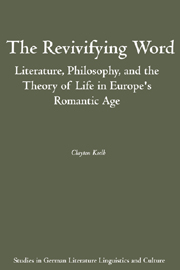Book contents
- Frontmatter
- Contents
- Preface
- Note on Abbreviations and Translations
- Part I Letter and Spirit
- Part II The Dead and Living Past
- 3 “The Heavenly Revelation of Her Spirit”: Goethe's The Sorrows of Young Werther
- 4 “O Read for Pity's Sake!”: Keats's Endymion
- 5 “Graecum Est, Non Legitur”: Hugo's Notre-Dame de Paris
- 6 “Spiritual Communication”: Gautier's Spirite
- Part III The Incarnate Word
- Conclusion
- Works Cited
- Index
6 - “Spiritual Communication”: Gautier's Spirite
from Part II - The Dead and Living Past
Published online by Cambridge University Press: 05 February 2013
- Frontmatter
- Contents
- Preface
- Note on Abbreviations and Translations
- Part I Letter and Spirit
- Part II The Dead and Living Past
- 3 “The Heavenly Revelation of Her Spirit”: Goethe's The Sorrows of Young Werther
- 4 “O Read for Pity's Sake!”: Keats's Endymion
- 5 “Graecum Est, Non Legitur”: Hugo's Notre-Dame de Paris
- 6 “Spiritual Communication”: Gautier's Spirite
- Part III The Incarnate Word
- Conclusion
- Works Cited
- Index
Summary
THE OPENING PARAGRAPHS OF Theophile Gautier's “fantastic tale” Spirite (1865) describe in considerable detail a quiet moment of reading in the life of the story's hero, Guy de Malivert:
Near him a lamp, placed in a stand of old crackled celadon, shed through its groundglass globe a soft, milky light, like moonbeams through a mist. The light fell upon a book which Guy held with a careless hand, and which was none else than Longfellow's “Evangeline.”
No doubt Guy was admiring the work of the greatest poet young America has yet produced, but he was in that lazy state of mind in which absence of thought is preferable to the finest thought expressed in sublime terms. He had read a few verses, then, without dropping his book [sans quitter le livre], had let his head rest upon the soft upholstering of the arm-chair, covered with a piece of lace, and was enjoying to the full the temporary stoppage of the working of his brain [il jouissait délicieusement de ce temps d'arrêt de son cerveau]. (GE 14; GF 35–36)
The relation depicted here between the reader and his book is odd enough to make one pause. The description begins conventionally enough: light, already transformed into a standard Romantic image, “moonbeams through a mist,” illuminates a book that was for many, already in 1865 when Gautier wrote this tale, the emblem of a certain sort of old-fashioned Romanticism.
- Type
- Chapter
- Information
- The Revivifying WordLiterature, Philosophy, and the Theory of Life in Europe's Romantic Age, pp. 97 - 110Publisher: Boydell & BrewerPrint publication year: 2008



